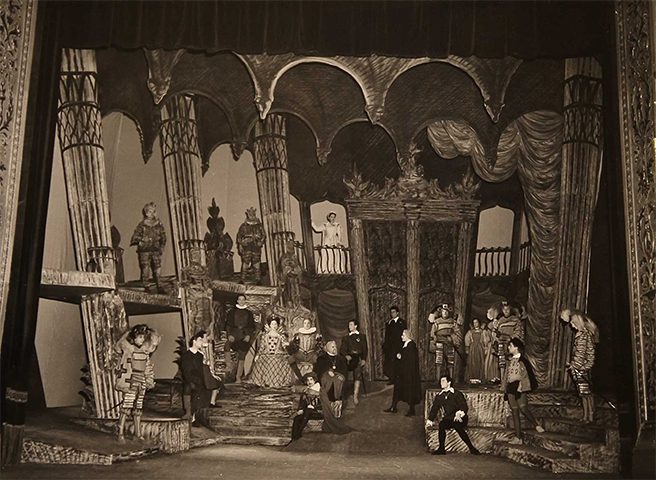Debutto: Roma, Teatro Valle, 28 novembre 1952
| Traduzione | Luigi Squarzina |
| Regia | Luigi Squarzina e Vittorio Gassman |
| Scene e costumi | Mario Chiari |
| Musiche | Giuseppe Piccioli |
| Produzione | Teatro D’Arte Italiano diretto da Vittorio Gassman e Luigi Squarzina |
Personaggi e interpreti
| Claudio, nuovo re di Danimarca | Mario Feliciani |
| Amleto, figlio del defunto re e nipote del regnante | Vittorio Gassman |
| Gertrude, regina di Danimarca e madre di Amleto | Elena Zareschi |
| Polonio, alto dignitario | Gianni Cavalieri |
| Ofelia, figlia di Polonio | Anna Proclemer |
| Fortebraccio, principe di Norvegia | Andrea Bosic |
| Laerte, figlio di Polonio | Luigi Vannucchi |
| Orazio, amico di Amleto | Carlo d’Angelo |
| Voltimando, ambasciatore in Norvegia | Stefano Varriale |
| Cornelio, cortigiano | Nerio Stucchi |
| Rosencrantz, cortigiano | Jacopo Tecchio |
| Guildenstern, cortigiano | Marcello Bertini |
| Osrico, cortigiano | Mico Cundari |
| Marcello, ufficiale danese | Sergio Fantoni |
| Francesco, soldato di guardia | Carlo Goni |
| Bernardo, soldato di guardia | Giovanni Conforti |
| Reginaldo, servo di Polonio | Cesare Tiani |
| Un capitano norvegese | Nino Conti |
| Primo attore | Lucio Ardenzi |
| Secondo attore | Franco Pastorino |
| Terzo attore | Giancarlo Gonfiantini |
| Primo becchino | Ferruccio Stagni |
| Secondo becchino | Franco Pastorino |
| Un prete | Stefano Varriale |
| Un messaggero | Renato Mori |
E’ la prima rappresentazione del Teatro d’Arte Italiano fondato e diretto da Luigi Squarzina e Vittorio Gassman. Il testo è tradotto da Squarzina e da lui messo in scena per la prima volta in Italia in edizione integrale. Lo spettacolo è corredato da assai corpose Note di regia che danno conto del lavoro di riflessione critica e di invenzione sottostante alla messinscena. Il senso dell’operazione è quindi spiegato dallo stesso Squarzina: “Restituire alla tragedia la sua integrità: rotto ad un uso secolare di mutilazioni o di divulgazioni malintese, il testo doveva apparire non soltanto nella sua vastità, ma nel suo linguaggio, nel suo ambiente naturale, nel suo ritmo, nella sua struttura, affinché il personaggio, svincolato dai luoghi comuni romantici e post-romantici, potesse ritrovare la sua coerente funzione di specchio di un’età in crisi”. La messinscena afferma con autorevolezza la concezione di regia in uno spettacolo che si qualifica come teatro d’attore. Squarzina inquadra la rappresentazione nelle leggi sceniche del teatro elisabettiano, ricostruendo il pensiero dell’autore e il contesto storico. Lo spettacolo suscitò l’entusiasmo irrefrenabile del pubblico che ogni sera accorreva assai più numeroso del pubblico che assisteva all’Eliseo al concorrente spettacolo Tre sorelle di Cechov allestito da Luchino Visconti.

